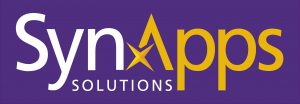 Since we last spoke, we’ve been busy making some improvements and changes to the way that we work here.
Since we last spoke, we’ve been busy making some improvements and changes to the way that we work here.
That’s mainly what I want to talk about today, though I do have a personal message to end with.
So, what’s been happening?
As you will have seen from our announcement in July, we have created a new management structure to help us make the most of changing circumstances and new opportunities.
There are two elements to this. One half is about the organic changes we are experiencing as a company. SynApps has done amazingly well since we were founded in the early ‘Noughts.’ We have secured two important partnerships, with EMC and with Alfresco, who form the bedrock of all we do here. I would also like to shout-out to another tech partner we’ve done some great work with, J4Care.
Working with these partners has helped us enter a lot of markets where we’ve done some great work. But SynApps is growing – and we’re fast-becoming a mid-sized company.
To service customers as a mid-sized company means a lot more process than when you’re an SME. You have to have real core corporate disciplines in place.
That’s why I have stepped up, with the permission of the board, to become co-CEO.
My colleague James Paton shares the responsibility with me. James has great experience in introducing standards and procedures like the ISO 27001 systems and bedding in our new sales automation tool, Salesforce, and will look after this side of the business and the service side. We are putting a lot more science into our budgeting, forecasting and pipeline, in order to be a slicker, more professional partner for bigger organisations. I know James has some discussion on that front that we’ll be publishing here soon.
My main focus is going to be on strategy and seeing where we need to take the company next. James and I see both roles as equally vital, which is why they need to be at the same level.
A special thanks to a certain Mr Whitelaw
It’s an exciting and challenging time, then. We know we have a lot of work to do. But that’s for the best reason – opportunity. We are doing well in interesting markets that are seeing the potential for ECM for the first time. With EMC, Alfresco and J4Care at our side, we are winning excellent business – especially in areas like the NHS.
So – changing circumstances, both inside SynApps and in the market. But, the other half of that change is the decision of Jim Whitelaw to pass the baton to myself and James.
Jim’s done some amazing work and the company wouldn’t be the same without his leadership and contribution. He’s retiring at the end of 2015, and it’s going to be sad to see him go. Many of the systems and structures I have discussed Jim spotted the need for and he spurred us on this path.
So – Jim, can I say, on behalf of both James and the rest of the SynApps team, how grateful we are that you took on the role of leading us from the front for so long. You’ve put us in a great position. Now it’s time – working with our customers – to make all that come to fruition.
What a year! Here’s to a very busy Q4 – it’s going to be a real landmark for us.
Speak soon,
Mark Winstone
Joint CEO and Sales & Marketing Director
SynApps Solutions

